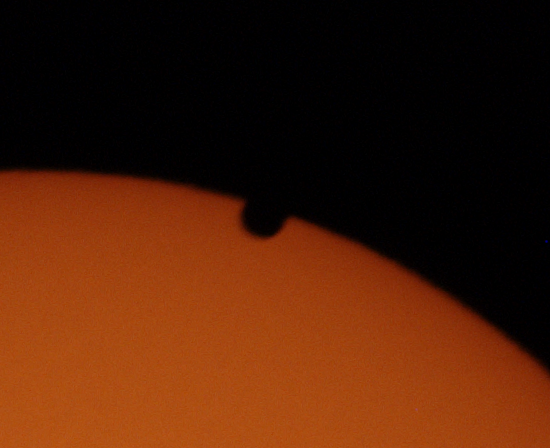The recent Venus transit is a great opportunity to take a look at a phenomenon that has plagued astronomers for hundreds of years. In fact, there is a bit of history to the black drop effect; there are reports of this effect that go back to the early days of transit observations, including
drawings of the stages of a Venus transit by Captain James Cook and Charles Green from observations they made in 1769. The black drop effect spoiled attempts to very accurately time the ingress of Venus, and set back efforts to improve measurements of the Earth's distance to the sun.
This year we got to look for the effect ourselves with the June 2012 transit, and among the huge stack of images I collected during the Chabot Space and Science Center event were these images. Notice the sun spots scattered around the disk of the sun, and the perfectly round nibble near the top edge.
 |
| Venus Transit, 5 June 2012 |
|
 |
| Venus Transit, 5 June 2012 |
|
These are zoomed out lots. So lets look closely at the first image. These next images are cropped from the previous images where Venus is entering the disk of the sun, then zoomed in a bunch.
Do you see it? Notice how the points where the edge of the disk of the sun and the edge of the disk of Venus meet. There should be sharp points there, but instead, it is rounded. Here is the same zoom from the later image.
This time Venus is far enough in that it should be surrounded by the yellow of the sun, but there is still that rounded opening. It is as if Venus is a drop of black fluid (oil?) falling into the fluid of the sun. Of course that's not the case, we know that Venus is a planet and the sun is the sun, so this black drop is an optical effect of some sort.
There have been a variety of explanations of this effect offered up, including:
- Venus has an atmosphere that must be distorting the image and causing the effect, or
- The Earth's atmosphere is distorting the image, or
- Limb darkening combine with instrument effects.
Ultimately, the explanation that I'm going with is that it is caused by a combination of sensor limitations and limb darkening
[here]. The experiment done in the linked paper looked for (and found) the black drop effect while looking at a Mercury transit (Mercury has no atmosphere) using a space telescope (outside the Earth's atmosphere). That pretty much ruled out any causes that involve atmospheric effects, and we are left with the limb darkening. So there it is. That's the story, and I'm sticking with it. As for actually observing it, there are the pictures. It is not as dramatic as I was expecting, but it sure is there.




No comments:
Post a Comment